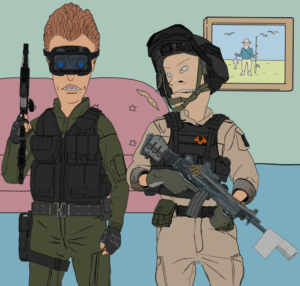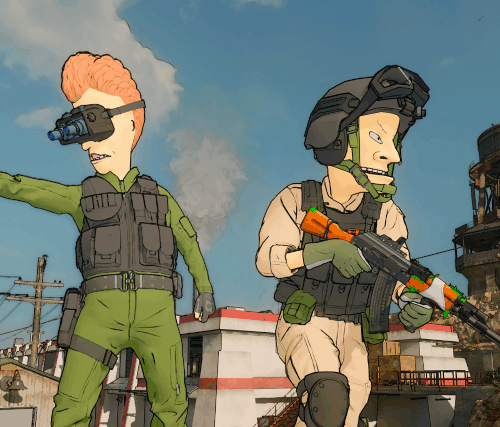In the high-stakes world of first-person shooters, where millions of players wage digital warfare daily, a peculiar battle has emerged that has nothing to do with bullets or explosions. Instead, it’s a conflict over identity, authenticity, and the increasingly blurred lines between entertainment and monetization. At the center of this controversy stands Activision’s Call of Duty franchise, grappling with a decision that has exposed the growing tension between corporate profits and community expectations.
The Rise of Cartoon Combat
 For years, Call of Duty has been evolving from its gritty, military-focused roots into something more akin to a digital carnival. What began as a series dedicated to authentic warfare experiences has gradually transformed into a platform where Beavis and Butthead can duke it out alongside WWE superstars and Family Guy characters on the battlefield. The inclusion of cosmetic skins featuring characters like Beavis and Butthead became a lucrative revenue stream for Activision, despite mounting criticism from the community.
For years, Call of Duty has been evolving from its gritty, military-focused roots into something more akin to a digital carnival. What began as a series dedicated to authentic warfare experiences has gradually transformed into a platform where Beavis and Butthead can duke it out alongside WWE superstars and Family Guy characters on the battlefield. The inclusion of cosmetic skins featuring characters like Beavis and Butthead became a lucrative revenue stream for Activision, despite mounting criticism from the community.
This transformation didn’t happen overnight. The cosmetic skin system, initially designed to offer players personal customization options, gradually morphed into a sophisticated monetization machine. Licensed collaborations with major entertainment brands became increasingly common, turning battlefields into surreal crossover events where cartoon characters wielded military-grade weaponry. While these partnerships generated substantial revenue through licensing deals, they also fundamentally altered the visual and tonal landscape of the game.
The business model was undeniably successful from a financial perspective. Players were willing to spend real money to embody their favorite fictional characters, creating a steady stream of post-launch revenue that traditional game sales alone couldn’t match. However, this success came at a cost that would only become apparent when faced with direct competition from a franchise promising a return to authenticity.
The Community Rebellion
The controversy reached a boiling point when Activision initially announced that cosmetic skins from Call of Duty: Black Ops 6 would carry forward into Black Ops 7, prompting significant community backlash. The reaction wasn’t just about aesthetic preferences; it represented a fundamental disagreement about what Call of Duty should represent as a gaming experience.
Long-time fans argued that the franchise had lost its identity, drifting too far from the tactical, military-focused gameplay that originally defined the series. The sight of cartoon characters running around realistic war zones created a cognitive dissonance that many players found jarring and immersion-breaking. Online forums and social media platforms became battlegrounds themselves, with passionate debates about whether Call of Duty had betrayed its core audience in pursuit of broader market appeal.
The community’s frustration wasn’t limited to aesthetic concerns. Many players felt that the focus on cosmetic monetization had come at the expense of core gameplay improvements and meaningful content updates. The perception that Activision prioritized skin sales over addressing longstanding technical issues and gameplay balance problems only amplified the criticism.
What made this backlash particularly significant was its timing. As players voiced their concerns about the direction of the franchise, a competitor was preparing to challenge Call of Duty’s dominance with a fundamentally different approach to cosmetic design and game identity.
Battlefield’s Strategic Positioning
 Enter Battlefield 6, positioned as the antithesis of Call of Duty’s cartoon-infused warfare. DICE, the developers behind Battlefield 6, made a strategic decision to commit to “grounded” and realistic cosmetics, explicitly contrasting their approach with Call of Duty’s more fantastical skins. This wasn’t just a design choice; it was a calculated market positioning that directly targeted Call of Duty’s perceived weakness.
Enter Battlefield 6, positioned as the antithesis of Call of Duty’s cartoon-infused warfare. DICE, the developers behind Battlefield 6, made a strategic decision to commit to “grounded” and realistic cosmetics, explicitly contrasting their approach with Call of Duty’s more fantastical skins. This wasn’t just a design choice; it was a calculated market positioning that directly targeted Call of Duty’s perceived weakness.
Battlefield 6’s design director emphasized the importance of maintaining immersion, stating that cosmetics “have to be grounded” and reminiscent of the more realistic approach seen in Battlefield 3 and 4. The messaging was clear: while Call of Duty offered spectacle and brand crossovers, Battlefield would provide authentic military simulation.
This positioning strategy was particularly clever because it didn’t just offer an alternative product; it offered an alternative philosophy. Battlefield 6’s marketing essentially argued that serious gamers deserved serious experiences, free from the commercialized carnival atmosphere that Call of Duty had embraced. The contrast was stark and intentional, designed to appeal to players who felt alienated by Call of Duty’s direction.
The competitive threat posed by Battlefield 6 wasn’t just about features or graphics; it was about capturing the zeitgeist of player sentiment. By positioning itself as the authentic alternative, Battlefield 6 could potentially capture market share from Call of Duty players seeking a more traditional military shooter experience.
Activision’s Calculated Response
Faced with mounting pressure, Activision reversed course with a statement acknowledging community feedback: “Some of you have said we’ve drifted from what made Call of Duty unique in the first place. That feedback hits home”. The company announced that Black Ops 6 cosmetics would no longer carry forward to Black Ops 7, effectively abandoning their previous commitment to cosmetic continuity.
However, this reversal raises important questions about Activision’s motivations. While the official statement emphasized listening to community feedback, the timing suggests that competitive pressure from Battlefield 6 played a significant role in the decision. The announcement came precisely when Battlefield 6 was gaining momentum with its authentic, grounded approach to cosmetics and gameplay.
In their official communication, Activision stated that “Black Ops 7 needs to feel authentic to Call of Duty and its setting,” suggesting a strategic pivot toward more realistic military themes. This language mirrors the messaging that Battlefield 6 had been using, indicating that Activision recognized the competitive threat posed by their rival’s positioning.
The decision to abandon cosmetic carry-forward represents more than just a policy change; it signals a fundamental reevaluation of the franchise’s direction. By choosing to reset the cosmetic ecosystem, Activision acknowledged that their previous approach had created problems that required drastic solutions.
The Consumer Backlash Dilemma
 The reversal of the carry-forward policy created an entirely new controversy, arguably more damaging than the original cosmetic concerns. Players who had purchased skins under the explicit promise that their investments would transfer to the next game suddenly found themselves facing a different reality. This situation highlighted the complex relationship between digital ownership, consumer expectations, and corporate policy changes.
The reversal of the carry-forward policy created an entirely new controversy, arguably more damaging than the original cosmetic concerns. Players who had purchased skins under the explicit promise that their investments would transfer to the next game suddenly found themselves facing a different reality. This situation highlighted the complex relationship between digital ownership, consumer expectations, and corporate policy changes.
The financial implications for affected players were substantial. Many had spent significant amounts of money on cosmetic items with the understanding that these purchases represented long-term investments in their gaming experience. The sudden policy change effectively rendered these investments obsolete, creating a sense of betrayal among the most engaged and financially committed players.
This second wave of controversy was potentially more damaging than the original because it involved concrete financial harm rather than abstract concerns about game identity. Players who might have accepted changes to aesthetic direction found it much harder to accept the loss of money they had already spent. The situation created a classic catch-22 for Activision: maintaining the carry-forward policy would perpetuate the authenticity problems that drove players to competitors, but abandoning it would anger their most dedicated customers.
The consumer protection implications of such policy changes also raised broader questions about digital ownership rights and corporate responsibility in the gaming industry. As games increasingly rely on post-launch monetization through cosmetic sales, the precedent set by Activision’s reversal could have far-reaching implications for how companies handle similar situations in the future.
The Authenticity vs. Monetization Paradox
 At its core, this controversy represents a fundamental tension between two different approaches to game design and monetization. On one side lies the pursuit of maximum revenue through broad market appeal and licensing partnerships. On the other side stands the desire for authentic, cohesive game experiences that maintain thematic consistency.
At its core, this controversy represents a fundamental tension between two different approaches to game design and monetization. On one side lies the pursuit of maximum revenue through broad market appeal and licensing partnerships. On the other side stands the desire for authentic, cohesive game experiences that maintain thematic consistency.
The success of cosmetic monetization in games like Fortnite demonstrated that players were willing to pay for personalization options, even when those options were fantastical or incongruous with the game’s setting. Call of Duty’s adoption of this model made financial sense but created tension with the franchise’s military shooter identity.
Battlefield 6’s commitment to realism represents a different philosophy: that maintaining thematic consistency and immersion can be a competitive advantage, even if it potentially limits monetization opportunities. This approach suggests that there may be market segments willing to sacrifice customization options for authentic experiences.
The question facing both franchises is whether these different approaches can coexist in the market, or whether one philosophy will ultimately prove more sustainable. The outcome of this competition could influence the direction of the entire first-person shooter genre.
Industry-Wide Implications
The Call of Duty cosmetic controversy extends beyond a single franchise dispute to reflect broader changes in the gaming industry. As games increasingly rely on live-service models and post-launch monetization, the tension between artistic vision and commercial viability becomes more pronounced.
The situation also highlights the growing power of community feedback in shaping corporate decisions. While companies have always been responsive to player concerns to some degree, the speed and scale of Activision’s reversal demonstrates how quickly market sentiment can force major policy changes in the modern gaming landscape.
The competitive dynamic between Call of Duty and Battlefield 6 over cosmetic authenticity may establish new benchmarks for how military shooter franchises approach visual design and monetization. Other developers will likely study this controversy carefully to understand how different approaches to cosmetic systems affect player retention and acquisition.
The Path Forward
 As the dust settles on this controversy, both Activision and their competitors face important decisions about how to balance commercial success with community expectations. The reversal on cosmetic carry-forward represents a significant concession to player demands, but it also creates new challenges around maintaining player trust and managing digital ownership expectations.
As the dust settles on this controversy, both Activision and their competitors face important decisions about how to balance commercial success with community expectations. The reversal on cosmetic carry-forward represents a significant concession to player demands, but it also creates new challenges around maintaining player trust and managing digital ownership expectations.
For Call of Duty, the challenge will be demonstrating that the commitment to authenticity is genuine rather than merely reactive to competitive pressure. Players will be watching closely to see whether Black Ops 7 truly delivers on promises of more grounded, realistic cosmetic options, or whether the franchise gradually drifts back toward its previous approach once competitive pressure subsides.
The broader gaming industry will also be watching to see how this situation affects player behavior and spending patterns. If Battlefield 6 successfully captures market share through its authentic approach, it could validate the strategy and encourage other developers to prioritize thematic consistency over broad monetization opportunities.
Ultimately, this controversy represents a pivotal moment in the evolution of first-person shooters, where the balance between commercial success and creative integrity is being actively negotiated by market forces, community feedback, and competitive pressure. The resolution of this conflict may well determine the future direction of one of gaming’s most lucrative and influential genres.
The lesson from this controversy extends beyond gaming: in an era where digital products can be rapidly modified and business models can shift overnight, companies must carefully consider the long-term implications of their monetization strategies on both brand identity and customer relationships. The true test of Activision’s course correction will be whether it successfully rebuilds player trust while maintaining the commercial success that modern game development demands.


